探索皮层微电路的结构偏差。
IF 2.1
4区 计算机科学
Q3 COMPUTER SCIENCE, ARTIFICIAL INTELLIGENCE
引用次数: 0
摘要
皮层在各种感知和认知功能中起着至关重要的作用,其基本单位是规范的皮层微回路。然而,我们仍然缺乏一个明确解释这一基本神经解剖学主题的结构-功能关系的框架。为了更好地理解皮层回路的物理基质如何促进其神经元动力学,我们采用了一种使用递归神经网络和表征分析的计算方法。我们研究了在整个学习过程中,不同神经元群在等级相关区域的微电路中的计算作用上,包含和排除生物动机的区域间层流连接所表现出的差异。我们的研究结果表明,反馈连接的存在与不同层皮层种群的功能模块化相关,并为微电路提供了自然的归纳偏置,以区分初始化时的预期和意外输入,我们在数学上证明了这一点。此外,当测试用预测编码启发策略训练微电路及其变体的效果时,我们发现这样做有助于在接收反馈的皮层区域更好地编码嘈杂的刺激,所有这些结合起来表明,预测编码机制在皮层中作为一种内在的操作逻辑。本文章由计算机程序翻译,如有差异,请以英文原文为准。
Exploring the Architectural Biases of the Cortical Microcircuit
The cortex plays a crucial role in various perceptual and cognitive functions, driven by its basic unit, the canonical cortical microcircuit. Yet, we remain short of a framework that definitively explains the structure-function relationships of this fundamental neuroanatomical motif. To better understand how physical substrates of cortical circuitry facilitate their neuronal dynamics, we employ a computational approach using recurrent neural networks and representational analyses. We examine the differences manifested by the inclusion and exclusion of biologically motivated interareal laminar connections on the computational roles of different neuronal populations in the microcircuit of hierarchically related areas throughout learning. Our findings show that the presence of feedback connections correlates with the functional modularization of cortical populations in different layers and provides the microcircuit with a natural inductive bias to differentiate expected and unexpected inputs at initialization, which we justify mathematically. Furthermore, when testing the effects of training the microcircuit and its variants with a predictive-coding-inspired strategy, we find that doing so helps better encode noisy stimuli in areas of the cortex that receive feedback, all of which combine to suggest evidence for a predictive-coding mechanism serving as an intrinsic operative logic in the cortex.
求助全文
通过发布文献求助,成功后即可免费获取论文全文。
去求助
来源期刊

Neural Computation
工程技术-计算机:人工智能
CiteScore
6.30
自引率
3.40%
发文量
83
审稿时长
3.0 months
期刊介绍:
Neural Computation is uniquely positioned at the crossroads between neuroscience and TMCS and welcomes the submission of original papers from all areas of TMCS, including: Advanced experimental design; Analysis of chemical sensor data; Connectomic reconstructions; Analysis of multielectrode and optical recordings; Genetic data for cell identity; Analysis of behavioral data; Multiscale models; Analysis of molecular mechanisms; Neuroinformatics; Analysis of brain imaging data; Neuromorphic engineering; Principles of neural coding, computation, circuit dynamics, and plasticity; Theories of brain function.
 求助内容:
求助内容: 应助结果提醒方式:
应助结果提醒方式:


